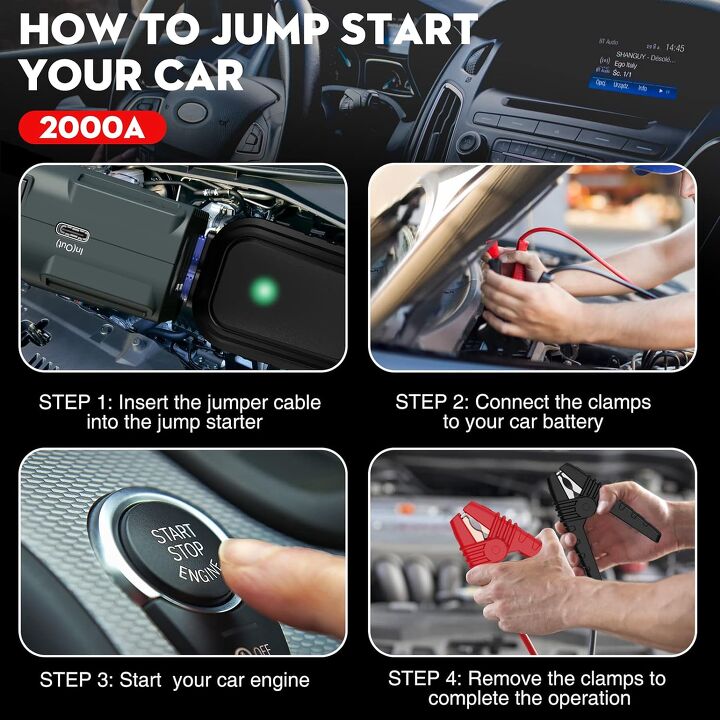How Many Amps Do I Need For A Portable Jump Starter?

The amount of amps you need from your portable jump starter depends on the type of vehicle you are trying to jump-start. Generally, smaller vehicles with smaller engines require less current, while larger vehicles with bigger engines need more. To determine the appropriate amperage, you need to consider the Cold Cranking Amps (CCA) rating of the vehicle's battery and the engine size.
Here's a detailed explanation and factors to consider in purchasing a portable jump starter:
Cold Cranking Amps (CCA):
CCA is a rating that indicates a battery's ability to start an engine in cold temperatures. It represents the current a battery can deliver for 30 seconds at 0°F (-18°C) without dropping below a specified voltage.
Check your vehicle's manual or the battery itself to find the CCA rating. This information is crucial because it gives you an idea of the power needed to start your vehicle in adverse conditions.
Engine Size:
The size of the engine is another important factor. Larger engines generally require more power to start.
Vehicles with larger displacement engines (e.g., trucks, SUVs) may need a higher amperage to effectively jump-start.
Promoted Product: TOPDON JumpSurge3000 Portable Jump Starter
Your vehicle’s battery doesn’t go dead when it’s convenient for you. Sometimes it happens when you don’t have access to another vehicle or jumper cables. This is where the TOPDON JumpeSurge3000 comes in.
The JumpSurge3000 is a 3000 Peak Amp portable jumpstarter that you can keep in your vehicle until you need it. This model is designed to work for vehicles with 12V batteries and up to 9L gas engines or 7L diesel engines.
More than just a one-hit wonder, the 24,000 mAh capacity of the JumpSurge3000 is capable of up to 45 jump starts on a single charge. It can bring your dead battery back to life in just a second.
TOPDON built in a number of safety features into the JumpSurge3000 designed to prevent the following hazards: reverse polarities, short circuits, over currents, reverse charges, over discharges, overheating, and low temperatures.
In addition to jump starting your battery, you can also use the JumpSurge3000 like a power bank to charge electronics via its USB Quick Charge 3.0 port. What’s more, it comes equjipped with an 400 lumen LED flashlight. It also offers an SOS setting to signal for help.
Recommended Amps for Jump Starter:
Portable jump starters usually come with a peak amperage rating and a continuous amperage rating. Peak amperage is the maximum current the jump starter can deliver for a short burst, while continuous amperage is the sustained current it can provide.
As a general guideline, a jump starter with a peak amperage rating around 400-600 amps is suitable for smaller vehicles with engines up to 3.0 liters. For larger vehicles with engines between 3.0 to 6.0 liters, you may need a jump starter with a peak amperage of 600-1000 amps or more.
Consideration for Extreme Conditions:
If you live in an extremely cold climate, it's advisable to choose a jump starter with a higher peak amperage, as starting a vehicle in very low temperatures requires more power.
Safety and Compatibility:
Ensure that the jump starter is compatible with your vehicle's battery type (e.g., lead-acid, AGM).
Always follow the manufacturer's recommendations and guidelines for safe usage.
In summary, to determine the amps you need from your portable jump starter, identify the CCA rating of your vehicle's battery, consider the engine size, and choose a jump starter with a peak amperage rating that meets or exceeds your vehicle's requirements. More is generally better, and having too many amps is generally better than not having enough.

Ross hosts The Hooniverse Podcast. He has been in the off-road world since he was a kid riding in the back of his dad’s YJ Wrangler. He works in marketing by day and in his free time contributes to Hooniverse, AutoGuide, and ATV.com, and in the past has contributed to UTV Driver, ATV Rider, and Everyday Driver. Ross drives a 2018 Lexus GX460 that is an ongoing build project featured on multiple websites and the podcast.
More by Ross Ballot




































Comments
Join the conversation